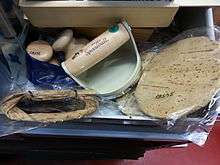Baren

Baren (馬連、馬楝) ![]() listen is a Japanese hand tool used in printmaking processes such as woodcut or lino cut.
listen is a Japanese hand tool used in printmaking processes such as woodcut or lino cut.
The baren is a disk-like device with a flat bottom and a knotted handle. Paper is placed on an inked block and the baren is used to burnish (firmly rub) the back of a sheet of paper to pick up ink from a wood or linoleum cut.
Process
The ink is rolled on with a hand roller called a brayer, but can also be applied to the block using brushes following the methods used in Japan where the baren originated. As well, some people use soluble pencils to colour the block and then dampen it before making a print.
Construction
The disk inside the baren takes 40–50 days to create, as the craftsman glues one sheet of paper on the disk each day. The disk must then dry for a year's time before the baren is assembled. The baren is made of layers, the paper backing, a flat coil of woven rope covering it, then a bamboo leaf covering the whole, twisted in such a manner as to form the handle on the top. Coil and covering of the baren are woven and formed from parts of the bamboo plant, requiring the skill of a true master. Only one known person in Japan is still making traditional baren for a living.
Alternatives
Large wooden spoons are also used as burnishing tools in printmaking, glass jars with a smooth circular base can also be used for some applications. Some new world barens are similar in shape to the traditional one with small metal ball bearings embedded in the bottom surface that generate the high point contact pressures (supplied by the braided cord) and have the low friction (offered by the bamboo leaf covering) of a traditional brayer. Another interesting baren is one developed by Professor Seishi Ozakus and made from a bundle of bamboo toothpicks.[1]
Nik Semenoff has developed a palm press that serves as a baren replacement, made with a number of roller bearings alternating on two close spaced shafts in a small hand held mounting. The bearings have negligible friction and the pressures achievable are suitable for some offset lithography printing, though wider spacing of fewer contact points may make it less suited for traditional wood cut printing.
References
External links
- The Baren Forum for Woodblock Printmaking
- Printing Etchings with a Palm Press - instructions for using Palm Press made from furniture casters